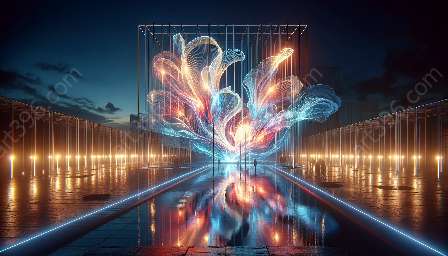Light art installations are a dynamic form of artistic expression that captivate and engage audiences. Understanding the role of color theory in creating impactful light art is essential for artists and designers seeking to evoke specific emotions and engage viewers in interactive experiences.
Color Theory Basics
Color theory is the study of how colors interact with each other and how they can be combined to create harmonious or contrasting effects. Artists and designers utilize color theory to convey moods, evoke emotions, and communicate messages through their work. The basic principles of color theory include the color wheel, color harmony, and color psychology.
Color Psychology in Light Art
Color psychology explores the emotional and psychological impact of color on human behavior and perception. In light art installations, colors can be strategically used to create immersive environments that evoke specific feelings and connections with the viewers. For example, warm colors like red, orange, and yellow may convey a sense of passion, energy, or excitement, while cool colors like blue, green, and purple can evoke feelings of tranquility, calmness, or introspection.
The interactivity in light art further amplifies the role of color psychology, allowing viewers to actively engage with the color palette and influence their own experiences through interaction with the artwork. Dynamic, interactive light installations inspire a sense of participation and co-creation, as the colors and their placements respond to the movements and actions of the audience, creating a personalized and immersive experience.
Color Harmony and Combinations
Color harmony refers to the arrangement of colors in a way that is aesthetically pleasing and balanced. In light art installations, understanding color harmony is crucial for creating impactful compositions that engage and captivate the audience. Complementary colors, analogous colors, and triadic color schemes can be utilized to establish visual balance and convey a sense of unity within the artwork.
Interactivity in light art installations can also play a role in exploring color harmony, allowing viewers to dynamically adjust the color combinations and experience the effects of different color harmonies in real time. This interactive element empowers viewers to become active participants in shaping the visual impact of the artwork, reinforcing their connection to the artistic experience.
Technological Advancements and Interactivity
The evolution of technology has significantly expanded the possibilities for interactivity in light art installations. Interactive lighting systems, responsive LED panels, and projection mapping techniques enable artists to create immersive and engaging environments that respond to the presence and actions of the audience. By integrating interactivity with color theory, artists can design light art installations that dynamically adjust color palettes, intensities, and patterns in response to the viewers' interactions, resulting in a multidimensional and personalized experience.
Conveying a Narrative Through Color
Color theory in light art installations can also be leveraged to convey narratives and evoke storytelling through the strategic use of color symbolism. By associating specific colors with themes, motifs, or emotions, artists can guide viewers through compelling visual narratives that unfold as they engage with the artwork. Interactivity further enriches the narrative potential, allowing the audience to become active participants in unraveling the layers of meaning embedded within the colors and their evolving relationships within the installation.
The combination of color theory, interactivity, and storytelling in light art installations creates a symbiotic relationship between the artist, the artwork, and the audience, fostering a dynamic and deeply engaging experience that transcends traditional boundaries of visual art.

